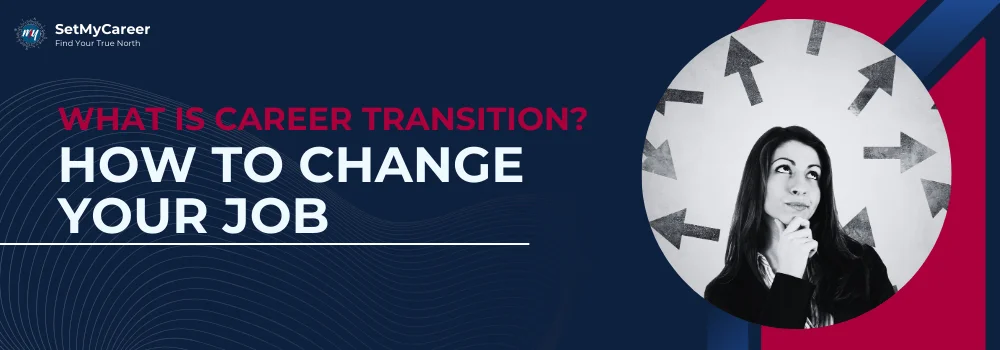Published by Jyothi Patil on 16 August 2023
Content Strategist | Editorial Team Member
Jyothi Patil is a skilled writer with a strong background in English literature, which she applies to crafting engaging content across various platforms. From writing blogs for her website and guest posts to creating pieces on Medium and Substack, Jyothi excels in making complex ideas easy to understand.
Feeling stuck in your job? Learn What is Career Transition and get tips on How to Change Your Job to align with your passions and goals.

Many working professionals reach this point in their lives when they feel lost, not feeling success or not satisfied with their current job. And finally they all come to a point called - Career Transition.
Some professionals can do Career Development in their current career and get a better position and in that they can get satisfied but on other hand some may need to change their career.
So Take a cup of coffee tea and sit somewhere comfortable. We will delve into the world of career transitions, changing careers for better opportunities, exploring what they are, why they matter, and how you can successfully navigate this exciting journey toward a more fulfilling future.
Let’s check what is career transition in detail and why you need to change your career.
Career transition, also known as career changes or switches, involves shifting from one profession or field to another. It’s a leap from your current job to a new path that better aligns with your goals, interests, and skills. Whether you’re a mid-career professional or restarting career after a break, these transitions provide opportunities for growth, self-discovery, and a renewed sense of passion in your professional life.
Now we know what is career transition, let's check the steps you have to take while preparing for a career change. We have explained the career transition steps in context to a person who is working as a Graphic Designer who wants to transition to a new career.

Step into the career you’ve always wanted—here’s how.
Transition NowSwathi, a talented Graphic Designer with an unyielding passion for creativity. She had spent years crafting visually stunning designs, but lately, a new dream had begun to take shape in her heart - a dream of venturing into the world of User Experience (UX) Design.
Let's check the steps she took while changing her career from graphic designer to UX designer
Swathi took some time to evaluate her current role and skills. She Considered where she excel at as a Graphic Designer, such as creating visually appealing designs, understanding color theory, and using design software. Based on the findings from current skills and job she found satisfying areas where she might excel and dissatisfying areas where she wants a change.
But She was not satisfied with her findings nor she was not sure about her skills and personality. So she took a psychometric career test to understand herself more. More about her personality, her interest, hidden abilities and behavior.
Once she knew about her Personality, abilities and hidden skills, she started to Explore alternative career paths that align with her skills and interests. She looks into roles like User Experience (UX) Designer, Web Designer, Art Director, or even roles in digital marketing. She researched these roles extensively to understand their responsibilities, required skills, and potential growth opportunities.
And She concluded her findings into 3 Jobs that aligns with her test results and skills
She compared her current skills with her findings, For instance UX Designer role, she might need skills like user research, wireframing, and interaction design. She identifies the gaps in her skill set that she needs to bridge.
But at this stage she was not sure about her findings, So she took career counseling sessions from experts who can help her to make the right decision. And after the session with the expert she decided to go with a career as a User Experience (UX) Designer.
She took additional Courses in UX designing to acquire missing skills and knowledge. She enrollled in online workshops, programs and study groups to know the basic principles and current trends in UX designing.
Once she got the necessary knowledge and skills she Revised her resume to highlight both her Graphic Design experience and skills like visual problem-solving and creativity that are valuable across design-related fields. She also Updated her LinkedIn profile to showcase her interest in the new career path as a UX designer.
Swathi rehearsed answers to questions about her transition, articulating how her Graphic Design background was her anchor in this brave new world. She also took Interview Preparation training to excel in the interview process.
And so, Swathi's story became one of courage, transformation, and unwavering determination. From the world of Graphic Design to the realm of User Experience, she proved that a heart full of passion and help from expert Career Counsellors can guide one through even the most challenging of career transitions.
Here are some common reasons why people consider changing their careers:
Successful career transitions are driven by self-assessment, research, and adaptability. Seeking guidance from career coaches can provide valuable insights, helping you navigate challenges and stay focused on your goals. Embrace the journey, remain resilient, and keep your end goal in sight.
No. 14/595, 1st Floor, Nanjappa Reddy Layout, Koramangala 8th Block, Bangalore 560095